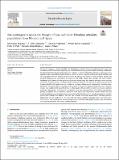Por favor, use este identificador para citar o enlazar a este item:
http://hdl.handle.net/10261/345919COMPARTIR / EXPORTAR:
 SHARE SHARE
 CORE
BASE CORE
BASE
|
|
| Visualizar otros formatos: MARC | Dublin Core | RDF | ORE | MODS | METS | DIDL | DATACITE | |

| Título: | Site-contingent responses to drought of core and relict Tetraclinis articulata populations from Morocco and Spain |
Autor: | Zemrani, Merouane; Camarero, Jesús Julio CSIC ORCID ; Valeriano, Cristina CSIC ORCID; Rubio-Cuadrado, Álvaro CSIC ORCID; Fulé, Peter Z.; Díaz-Delgado, Ricardo CSIC ORCID ; Taïqui, L. | Palabras clave: | Climwin North Atlantic Oscillation Vaganov-Shashkin model |
Fecha de publicación: | ago-2023 | Editor: | Elsevier | Citación: | Dendrochronologia 80: 126103 (2023) | Resumen: | The growth responses to climate variability are still unknown in locally threatened conifers from dry regions, but this information is necessary for improving the conservation of relict populations under increasing aridification. We characterized the radial growth patterns and responses to climate of Tetraclinis articulata, a Cupressaceae tree endemic to the western Mediterranean Basin, in a relict population located in southwestern Spain (Doñana) and two populations from the northern Morocco where the species core habitat is found (Tétouan, Ifarten). We assessed climate-growth relationships by using tree-ring width, climate data, drought and North Atlantic Oscillation (NAO) indices. Climate-growth analyses were refined using the climwin R package to select the most informative statistical models. The main climatic constraints of growth were inferred by using the process-based Vaganov-Shashkin (VS) model explicitly considering non-linear climate-growth relationships. Tetraclinis articulata growth was favored by wet conditions from the prior autumn to the spring of the growth year. In Doñana, warmer May conditions led to growth decline but this negative effect could be reversed by wet-warm conditions in the prior late autumn. Growth in the two Moroccan sites was constrained by 6- to 18-month long droughts peaking in summer, which account for cumulative water deficit since the previous autumn. Winter and early spring precipitation were the main climate drivers of growth in the Moroccan T. articulata populations, and their year-to-year variability was linked to the NAO. The VS model simulations showed that T. articulata growth is enhanced by wet soil conditions in late winter and early spring, probably recharging shallow soil water pools. The VS model also confirmed that warmer spring-summer conditions could amplify drought stress and threaten the long-term persistence of the relict Doñana population. | Descripción: | © 2023 The Author(s). Published by Elsevier GmbH. This is an open access article under the CC BY license (http://creativecommons.org/licenses/by/4.0/). | Versión del editor: | https://doi.org/10.1016/j.dendro.2023.126103 | URI: | http://hdl.handle.net/10261/345919 | DOI: | 10.1016/j.dendro.2023.126103 | ISSN: | 1125-7865 | E-ISSN: | 1612-0051 |
| Aparece en las colecciones: | (IPE) Artículos (EBD) Artículos |
Ficheros en este ítem:
| Fichero | Descripción | Tamaño | Formato | |
|---|---|---|---|---|
| Site-contingent_Dendrochronologia_2023_OA.pdf | 4,17 MB | Adobe PDF |  Visualizar/Abrir |
CORE Recommender
SCOPUSTM
Citations
2
checked on 22-abr-2024
WEB OF SCIENCETM
Citations
2
checked on 24-feb-2024
Page view(s)
23
checked on 18-may-2024
Download(s)
12
checked on 18-may-2024
Google ScholarTM
Check
Altmetric
Altmetric
Este item está licenciado bajo una Licencia Creative Commons

